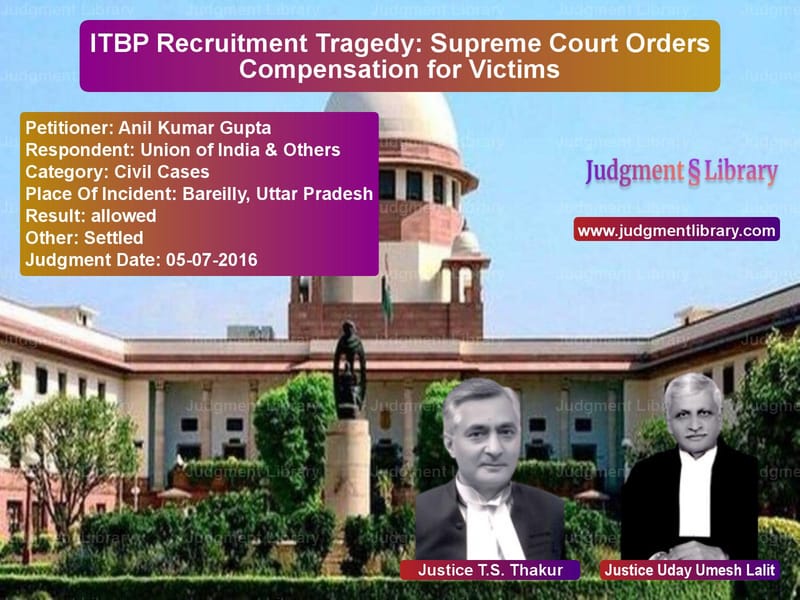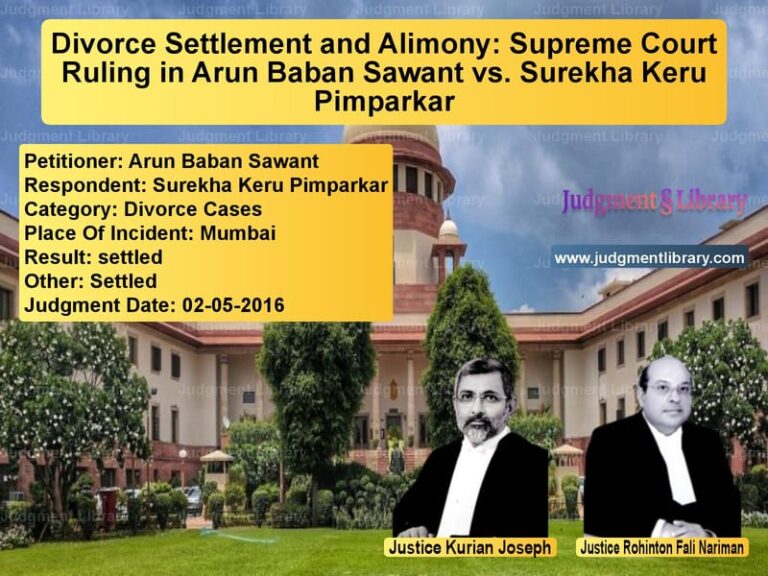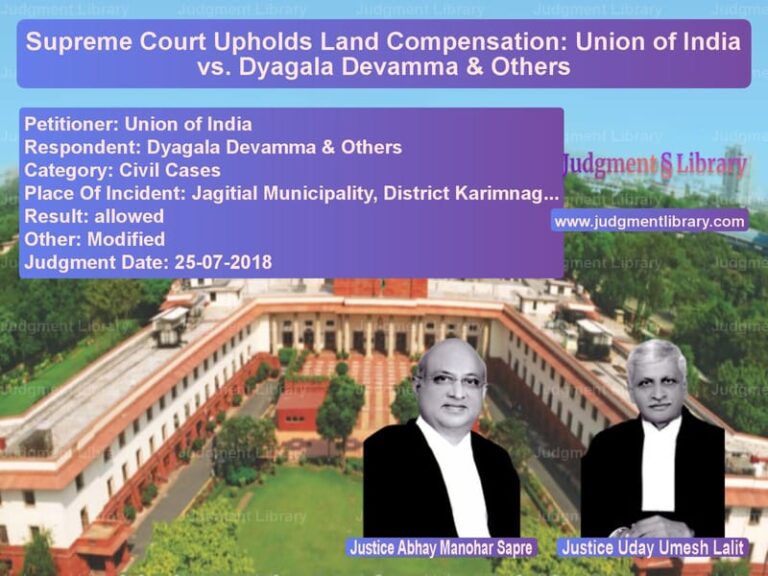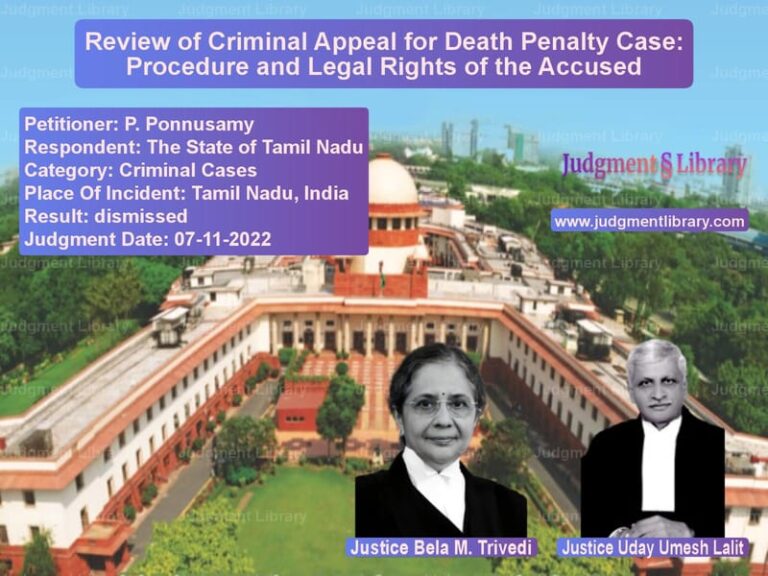ITBP Recruitment Tragedy: Supreme Court Orders Compensation for Victims
The case of Anil Kumar Gupta vs. Union of India & Others is a significant ruling where the Supreme Court addressed the tragic incident that occurred on February 1, 2011, during a recruitment drive conducted by the Indo-Tibetan Border Police (ITBP) in Bareilly, Uttar Pradesh. The incident resulted in the deaths of at least 20 candidates and serious injuries to several others due to overcrowding and mismanagement.
Background of the Case
The ITBP had announced a recruitment drive for 416 posts of Class IV employees. Candidates from 11 states were invited to submit their applications in person at the ITBP headquarters in Bareilly. However, by the morning of February 1, 2011, over two lakh aspirants had arrived, creating an unmanageable situation.
As the crowd grew, law enforcement authorities struggled to maintain order. The officers resorted to lathi charge and tear gas to disperse the crowd, leading to panic and chaos. In a desperate attempt to leave the city, hundreds of candidates climbed atop the Himgiri Express train heading towards Eastern Uttar Pradesh and Bihar.
The Tragic Accident
The train, packed with passengers on the roof, departed from Shahjahanpur Railway Station at a high speed of 75 kmph. As it approached the Hathaurda Railway Over Bridge, near Mohammadabad Crossing, the low clearance of the bridge resulted in a horrific accident. The impact instantly killed at least 14 individuals, while 20 others suffered severe injuries. Some victims fell from the train, and others were electrocuted when high-tension wires snapped.
Legal Issues Raised
- Who was responsible for the tragedy—the ITBP, the Railways, or the aspirants?
- Was the Railway Administration negligent in allowing the train to run at such high speed?
- What measures should be taken to prevent similar incidents in the future?
- Should the victims’ families receive compensation?
Arguments of the Petitioner (Anil Kumar Gupta)
The petitioner, an advocate, filed a writ petition under Article 32 of the Indian Constitution, arguing:
- The ITBP and Railways failed in their duty to manage the situation.
- Law enforcement agencies used excessive force, worsening the crisis.
- Authorities failed to ensure the safety of aspirants during the recruitment process.
- The victims’ families should receive financial assistance and compensation.
Arguments of the Respondents (Union of India & Railways)
The government and railway authorities contended:
- Announcements were made urging candidates not to climb onto train rooftops.
- The train was moved on police orders to avoid a stampede at the station.
- The primary responsibility for the deaths rested with the individuals who violated safety rules.
- There was no official negligence on the part of railway authorities.
Supreme Court’s Observations
The Supreme Court reviewed official reports, including the Enquiry Report by Commissioner of Railway Safety. The key findings were:
- There was an infringement of 55mm in vertical clearance at the railway bridge.
- The train was running at 75 kmph, an unsafe speed under the given circumstances.
- Railway authorities did not take adequate precautions despite knowing the risks.
- The ITBP failed to control the crowd, leading to mass panic.
Key Extracts from the Judgment
The Supreme Court ruled:
“The Railway Administration must take responsibility for allowing the train to run at high speed despite knowing the dangers posed by overcrowding.”
The Court further directed:
“ITBP and other Central Police Organizations must issue strict guidelines limiting the number of candidates allowed per recruitment cycle to prevent overcrowding.”
Final Judgment
The Supreme Court directed the Railways to compensate victims as follows:
- ₹5 lakh to the families of each deceased victim.
- ₹1.5 lakh for those who suffered permanent disability.
- ₹75,000 for grievous injuries.
- ₹25,000 for minor injuries.
Impact of the Judgment
The ruling has several far-reaching implications:
- It ensures that public authorities are held accountable for mismanagement.
- It establishes clear liability for railway accidents caused due to administrative lapses.
- It mandates procedural reforms in government recruitment drives.
- It sets a precedent for future cases involving crowd control and public safety.
Conclusion
The Supreme Court’s decision in Anil Kumar Gupta vs. Union of India underscores the importance of public safety and accountability. By ordering compensation and directing procedural reforms, the judgment seeks to prevent such tragic incidents in the future. It serves as a reminder that public institutions must take proactive measures to safeguard lives.
Don’t miss out on the full details! Download the complete judgment in PDF format below and gain valuable insights instantly!
Download Judgment: Anil Kumar Gupta vs Union of India & Oth Supreme Court of India Judgment Dated 05-07-2016-1741873086116.pdf
Direct Downlaod Judgment: Direct downlaod this Judgment
See all petitions in Damages and Compensation
See all petitions in Judgment by T.S. Thakur
See all petitions in Judgment by Uday Umesh Lalit
See all petitions in allowed
See all petitions in settled
See all petitions in supreme court of India judgments July 2016
See all petitions in 2016 judgments
See all posts in Civil Cases Category
See all allowed petitions in Civil Cases Category
See all Dismissed petitions in Civil Cases Category
See all partially allowed petitions in Civil Cases Category







